Get ready for a perfect winter festive dessert that's super delicious. Rhubarb, Custard and Gingerbread Trifles are a magical mix of flavours and textures. Each spoonful is a party in your mouth. It's sweet and a little sour. It's a perfect size to be decadent but not coma-inducing.
How could anyone handed this dessert not smile? Whether it's a holiday party or a cozy family gathering.... Rhubarb, Custard and Gingerbread trifles are worth the effort.

This stunning dessert features layers of:
- rhubarb compote - a chunky fruit puree that is equal parts sweet and sour.
- ginger cake drizzled with fruity liqueur or OJ - shop-bought or make your own.
- rhubarb jelly - softly set, made from the juices from our rhubarb compote (very easy to make).
- rich creamy pastry cream - a dollop-able (rather than pouring) custard. Perfect for layering- shop-bought or make your own.
- softly whipped cream- slightly sweetened and flecked with vanilla seeds.
- gingerbread biscuit crumb - shop-bought or make your own.
This recipe is for 12 individual trifles made in glasses around 160ml capacity. Of course, you can build up the layers in one large glass bowl (about 2L capacity) instead - it will still taste and look incredible. This will obviously be a lot quicker to assemble. If you're really sure you don't need so many, you can easily scale down the recipe.
There's no way I'm going to tell you that this is a quick dessert to throw together. It is easy though. No special cooking skills or equipment needed. You can 'cheat' a little and used ready made ginger cake, custard and gingerbread biscuit. You might choose to make one or all these things yourself (recipe links are all provided in this post). Have a go at making the rhubarb compote and jelly though. I've never seen commercially available versions of either of these things. The compote is a matter of baking rhubarb slices with sugar. We make the jelly with the juices drained from the baked rhubarb. All we do is add some dissolved gelatine and water and refrigerate to set. That's it!
❓FAQs
I know you're like, that all sounds amazing, but how long are they going to take to make? Of course, this depends on whether you're making all the parts yourself. The jelly and the custard both need a few hours to set and chill. I would recommend starting at least the day before. If making your own ginger cake, it's even more delicious made a few days in advance. It gets even more sticky and yummy. If making your own gingerbread biscuits, you can do this a few days in advance too. As with most trifles, this is a cooking project best done over a few days.
It's the fresh fruit in a lot of trifles that limits you. Fresh soft fruits like berries spoil quickly. The rhubarb here is stewed and keeps well. You can make all the components except the whipped cream in advance. In fact, I fully assembled the trifles for these photos. They did not go to waste! We very much enjoyed them over four days. Freshly whipped cream is always nicer though and the biscuit crumb gets a little soft in the fridge. The rest of the layers are just as good four days later as freshly made. You can make the layers over a few days. Either keep them separate or start building them in your serving glasses. Keep them well covered in the fridge. For best results, hold off on whipping and adding the cream topping until the day of serving. Sprinkle over the gingerbread biscuit crumb as you serve to keep it crisp.
Trifle is a traditional British dessert often served at Christmas in a huge deep glass bowl. It looks stunning! It's a real showstopper of a dessert for a crowd. You must make sure everyone gets a good look at it before you remove the first portion. Make sure you dig deep to get all the layers. The beautiful trifle usually collapses in on itself, which is a bit sad. This did, however, have its advantages when it came to eating the leftovers. It was easier to eat the layers you like the most (custard in my case) without the rest of the family noticing as much 😊
I've developed these individual trifles because I want every single serving of trifle to be just so. A perfectly neat, proportioned, beautiful dessert for every eater. What's better than having dessert? Having your own dessert that you don't have to share! There's no being polite and saying, 'just a little piece for me!' (and then hating yourself). Individual desserts are (usually) generously portioned and you get to eat it all.
Glass is important - we want to show off those layers we took the time and effort to build. If you're going to serve individual portions of a dessert in a glass, it's nice to present the glasses filled to the brim.
I've 'done the hard yards' so that you don't have to. There's been a bit of trial and error getting the quantities right for these trifles. I started off with half-filling water glasses. The trifles were generously portioned (they were big glasses). They still managed to look a bit half-eaten and sorry for themselves.
Next time, I filled the same glasses to the brim. They looked amazing but were completely ma-hoosive. I was the only person who could finish a serving. That's only because I'm completely stubborn and was trying to convince myself that they weren't too big.
I conceded that to make these work, I needed to source smaller glasses. I happened upon twelve 160ml water glasses in a local charity shop. Yes!!
Now, I don't expect you to source twelve glasses that are exactly 160ml to make this recipe. Something around that size will work, they don't even have to match. If your glasses are bigger, they will be slightly less generously filled. Smaller and you might have some filling left over. No biggy. All the layers taste amazing, in combination or by themselves.
You can enjoy these all year round. Rhubarb is in season during the winter months. This vegetable (you thought is was a fruit, didn't you?) is more readily available and fresher in winter.
For the most part. I know that's a wishy-washy answer, but we know that we talk about low FODMAP, not no FODMAP. Rhubarb is naturally low FODMAP. The compote, jelly, fruit, custard and cream layers are all low FODMAP with caveats. You need to use lactose-free cream for the whipped cream top and lactose-free milk in the pastry cream. My recipes for ginger cake and gingerbread biscuit are NOT gluten-free. But, these are present in each portion in relatively small amounts. I eat a whole serving of Rhubarb, Custard and Gingerbread Trifle with no associated FODMAP woes.
NB: Gelatine (used to make the jelly and found is most jellies) is NOT vegetarian.
It can do. You drizzle about a teaspoon of liquid over the cake to infuse it with flavour. You can use fruit juice or fruity alcohol (or skip this step). You can make your own one particularly boozy if you like….make sure you don't get it mixed up with the kids'. I label the underneath of the boozy portions with a short section of masking tape. Don't tilt the glasses upside down to check though 😊
The Layers
Rhubarb Compote & Jelly
I've grouped these steps together because the jelly is a wonderful by-product of the compote. The photo below shows the ingredients needed to make both (very few!). We add sugar to chopped rhubarb stalks to make the compote. The juices drained from the compote make a wonderful rhubarb jelly. Very little extra effort required. Gelatine dissolved in cold water is the setting agent. We make up the rhubarb juice with some extra water to create a wonderful fragrant softly set jelly.
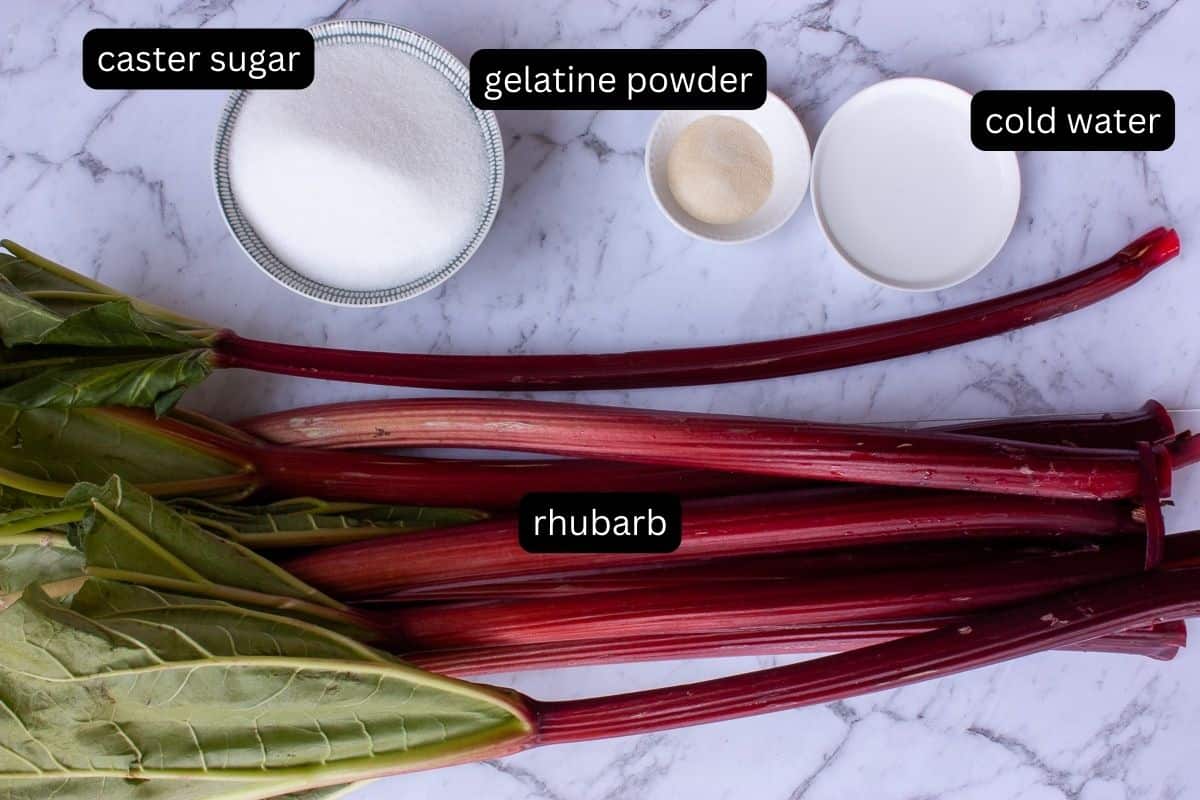
We trim and discard the leaves of the rhubarb (fun fact: these are poisonous if eaten in large amounts). Chop the stalks into short lengths. Sprinkle generously with sugar and bake, covered, until softened and falling apart. The fourth photo in the collage below is the halfway point during baking. The rhubarb has begun to soften. You can see the difference at the end of cooking time (5th photo).. The rhubarb has completely collapsed and has begun to disintegrate.
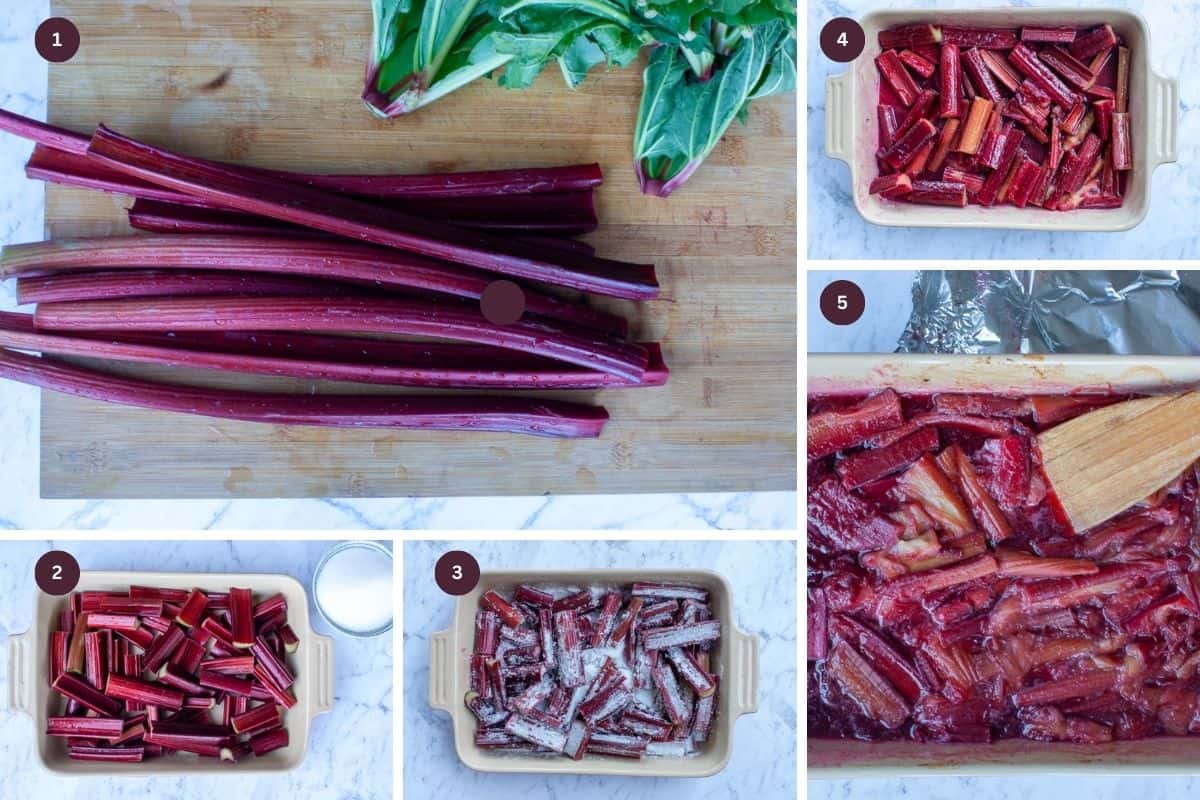
Tips on using gelatine
Put a small amount of water in a shallow dish and lightly sprinkle over the gelatine powder. You'll see it sink into and dissolve into the water (photos 1 and 2 in the collage below). If there are any white powdery bits remaining, drizzle a little more water over this.
Don't make the mistake of using gelatine that is not fully dissolved in water. It won't dissolve any further later and you'll have weird blobby bits floating around your jelly liquid. It's worth straining your jelly liquid through a sieve. This ensures you get any undissolved bits of gelatine out before chilling. As long as there's not loads of undissolved gelatine, your jelly will still set, don't worry. Photo 3 shows the compote draining over a bowl. We use the juice collected from this to make up the jelly. Pour this into a measuring jug. Stir though the dissolved gelatine and make up the volume to 500ml. Pour slowly through a sieve into a dish to make a shallow layer to chill. This makes it easy to divide into portions for each trifle once set.
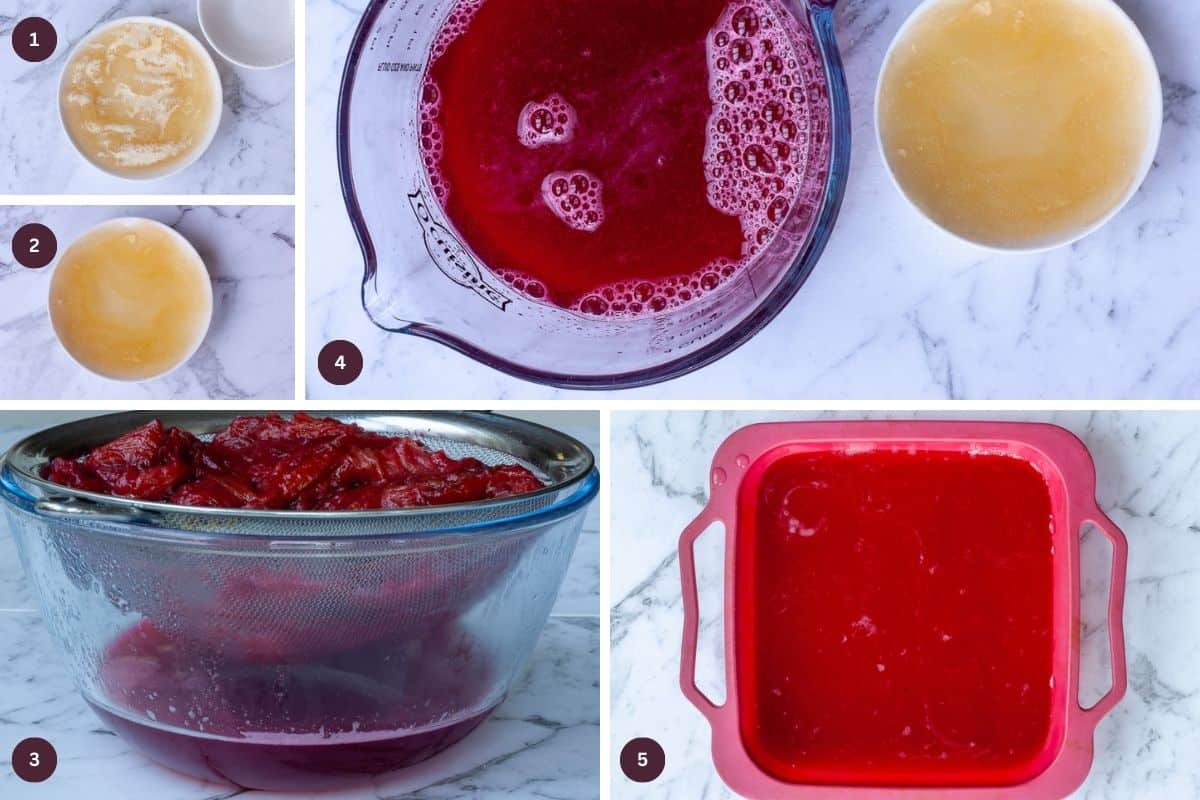
Gingerbread Cake
We need enough to cut twelve discs about a centimetre thick to fit each glass. For mine I use a 4cm cutter. You can buy ready-made or make your own. If making this recipe, you'll only need a about a quarter of the cake for all the trifles. You can enjoy the rest on its own - it keeps well, up to a week at room temperature or a few months in the freezer.
Pastry Cream
If you're buying ready-made, find a nice thick custard. Otherwise make your own. One batch of my pastry cream is the perfect amount for these trifles.
Whipped Cream
Thickened (or 'double' cream) with a touch of icing sugar and some vanilla paste. I like to use the paste (rather than extract). The little black dots of the vanilla seeds are a nice visual touch.
Gingerbread Biscuits
We roughly chop these to provide crunchy contrast to the creamy elements of the trifle. You can buy ready made or make your own. You'll only need a few.
Don't be tempted to process the gingerbread biscuits to make a crumb. It will threaten to choke you if you inhale! It looks good chunky, and it's more recognisable as gingerbread.
🧩Putting It Together
Try to drop the layers into the centre of the glasses. Avoid smearing layers down the sides of the inside of the glass on the way in. Use a teaspoon to gently coax the liquid layers - compote, custard and cream - to the sides. You can push down into the layer beneath slightly. This helps get rid of big air bubbles for a more profesh appearance. Of course, you don't have to stick to the order I've given here.
Rhubarb compote
Use about 2 tablespoons of compote per portion (about 40g). If you want to be super-precise, you can set each glass on weighing scales and tare (zero). You can weigh the compote directly in the glass.
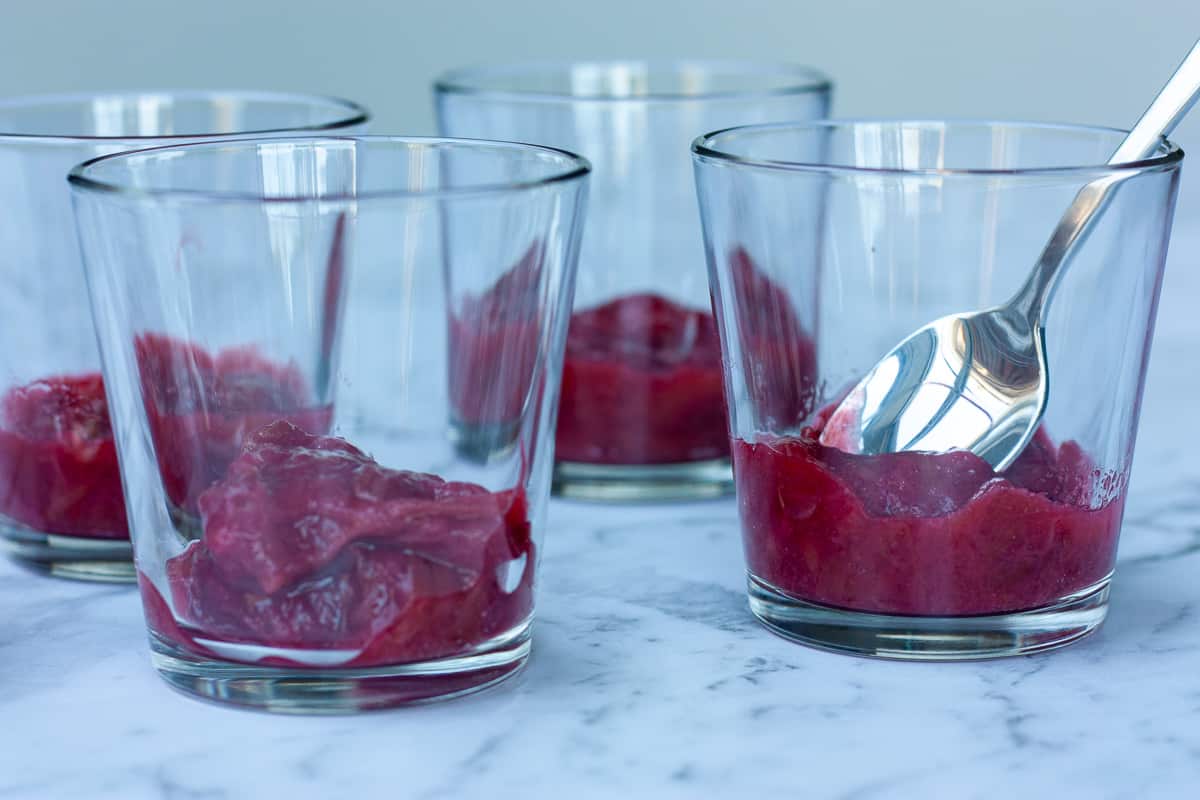
Ginger Cake
Cut slices about 1cm thick. Use a cutter to press out discs to fit your glasses. Nibble on the offcuts 😛. Once in the glass, drizzle over about a teaspoon (or more!) of your preferred liquid, either alcoholic or not.
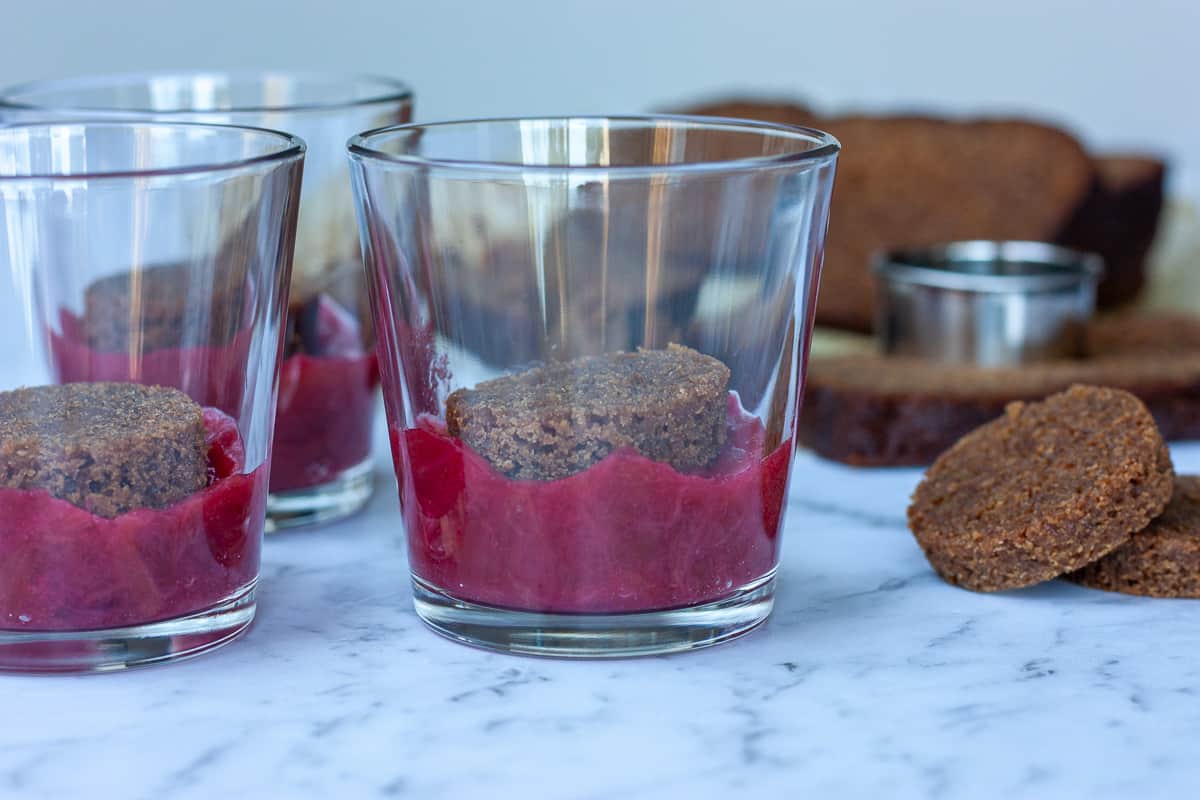
Rhubarb Jelly
Use a butter knife to divide the jelly layer into twelve. Transfer each section to a small dish and cut up into little cubes before tumbling into each glass.
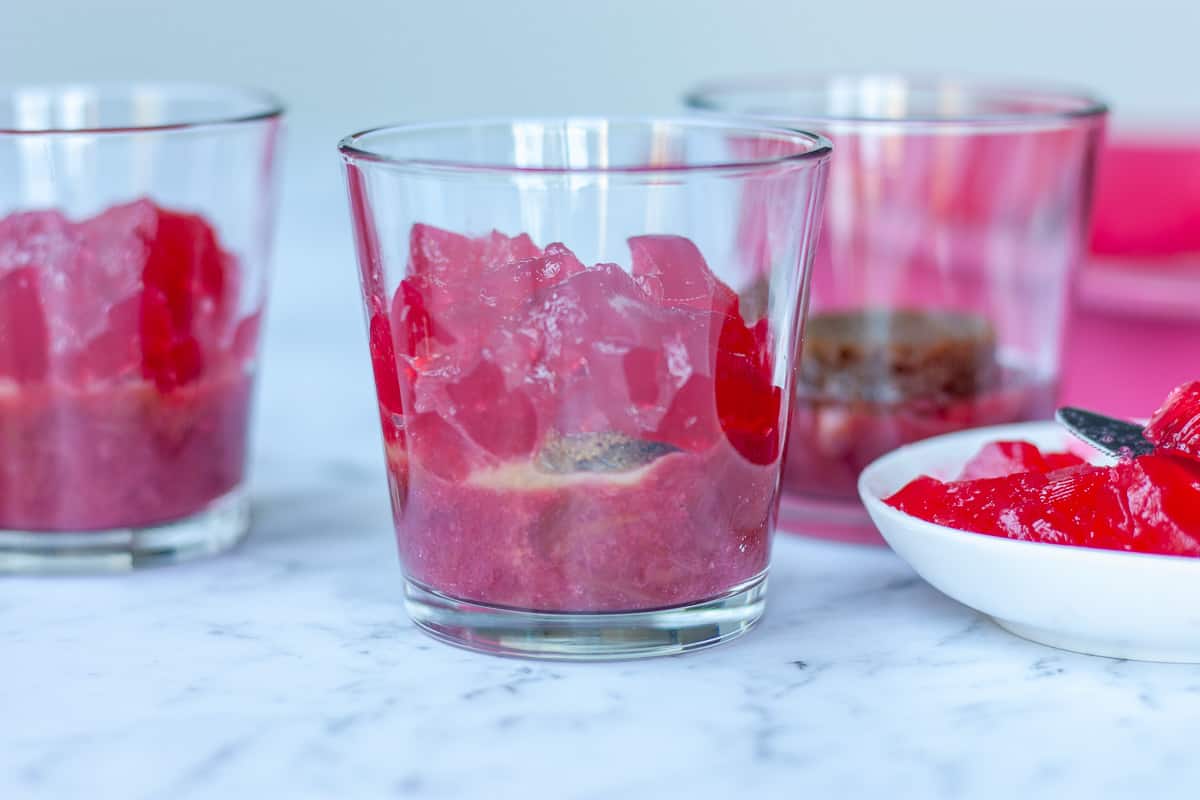
Pastry Cream
Around 3 tablespoons per portion (about 50g).

Whipped Cream
About a tablespoon per portion.
Gingerbread Biscuit
Roughly chop and top each trifle with about about a teaspoon's worth.
📖 Recipe
Equipment
- 12 small water glasses, with a capacity of around 160ml OR one large trifle bowl approx. 2L capacity
- Ovenproof dish - large enough to take the trimmed and chopped rhubarb one layer deep
Ingredients
Rhubarb Compote & Jelly
- Approx. 1 Kg fresh rhubarb trimmed weight - 10-15 stalks, depending on their thickness
- 250 g caster sugar
- 2 teaspoons gelatine powder
- 2 Tablespoons cold water
Ginger Cake - ready-made or make your own.
60ml Orange Juice or fruit-flavoured liquor - such as Chambord or Cointreau (note)
500-600ml Pastry Cream - ready made or make your own
Whipped Cream
- 300 ml double cream *lactose free
- Tablespoon icing sugar
- teaspoon vanilla paste
Gingerbread Biscuits - ready-made or make your own.
Instructions
Rhubarb Compote
- Preheat Oven - to 180°C
- Prepare Rhubarb - trim both ends of the stalks, discarding any leaves. Rinse the stalks. Cut into small lengths and transfer to your oven dish.Approx. 1 Kg fresh rhubarb
- Sugar - sprinkle over the rhubarb and stir through.250 g caster sugar
- Bake - cover the dish with foil. Cook until the stalks are tender, about 40 minutes, stirring half way through.
- Strain - tip the rhubarb into a sieve over a bowl (retaining the juices) & leave to drain for around 15 minutes. There will be 300-400ml of liquid. Don't worry about this amount too much - we will make up the quantity with water. No need to press out the compote.
- Refrigerate - transfer the strained rhubarb to a bowl, cover and put in the fridge for later. This will form the fruit layer of the trifle
Rhubarb Jelly
- Bloom Gelatine - sprinkle the gelatine over the cold water in a small dish or bowl. Leave to stand for 5-10 minutes. If there are any undissolved granules, sprinkle a little more cold water over the top.2 teaspoons gelatine powder2 Tablespoons cold water
- Heat Rhubarb Juice - pour the syrup from step collected from the compote into a measuring jug. Microwave until hot, around 30 seconds.
- Add Gelatine - add dissolved gelatine to the measuring jug and stir to combine.
- Dilute - make up volume of rhubarb juice to 500ml with cold water. Stir well.
- Refrigerate - pour the jelly mix slowly through a sieve into a shallow dish. with plastic wrap and leave to set in the fridge for at least four hours.
Cream
- Softly Whip - combine the cream, sieved icing sugar and vanilla extract in a large bowl. Whisk by hand until soft peaks form.300 ml double creamTablespoon icing sugarteaspoon vanilla paste
Assembling the Trifles
- Compote - use tongs to pick up a couple of tablespoons-worth of rhubarb compote (approx. 40g) and place in the middle of the base of each glass, then spread evenly. Press out any air bubbles by working the compote into the corners with a teaspoon.
- Ginger Cake- place a round of gingerbread in each glass and press down. About 1cm thick. The size of the cutter you need will depend on how wide your glasses are.
- Liquid - drizzle a teaspoon of orange juice or liquor over the biscuit.
- Jelly - cut the jelly into 12 portions. Transfer each portion to a small dish and cut into cubes. Tumble into the centre of each glass. Spread out with a teaspoon if required.
- Custard - spoon in about two Tablespoons-worth (50g) of custard into each glass. Use a teaspoon to swirl out to make an even layer and push between the jelly cubes. Cover well and refrigerate.
- Shortly Before Serving - spoon in about a tablespoon of whipped cream into each glass. Use a teaspoon to spread out.
- To Serve - roughly chop some gingerbread biscuit to sprinkle over the tops to decorate.

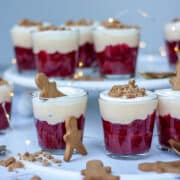
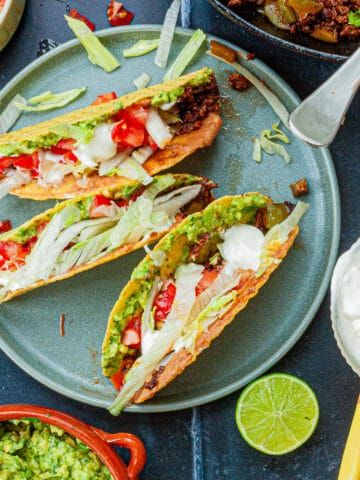


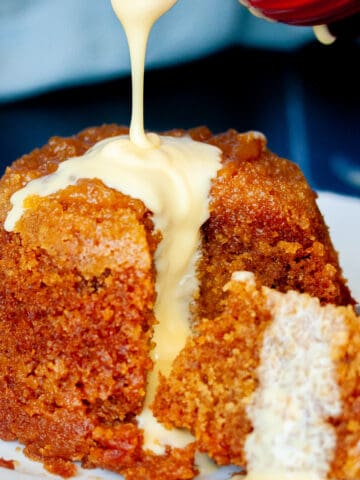
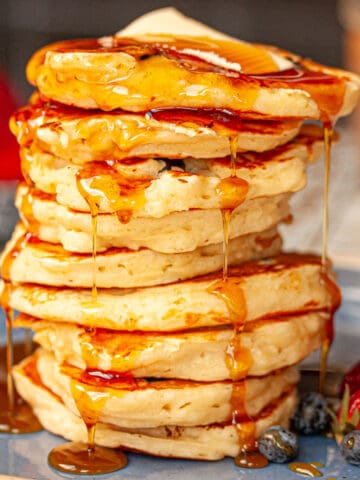
Comments